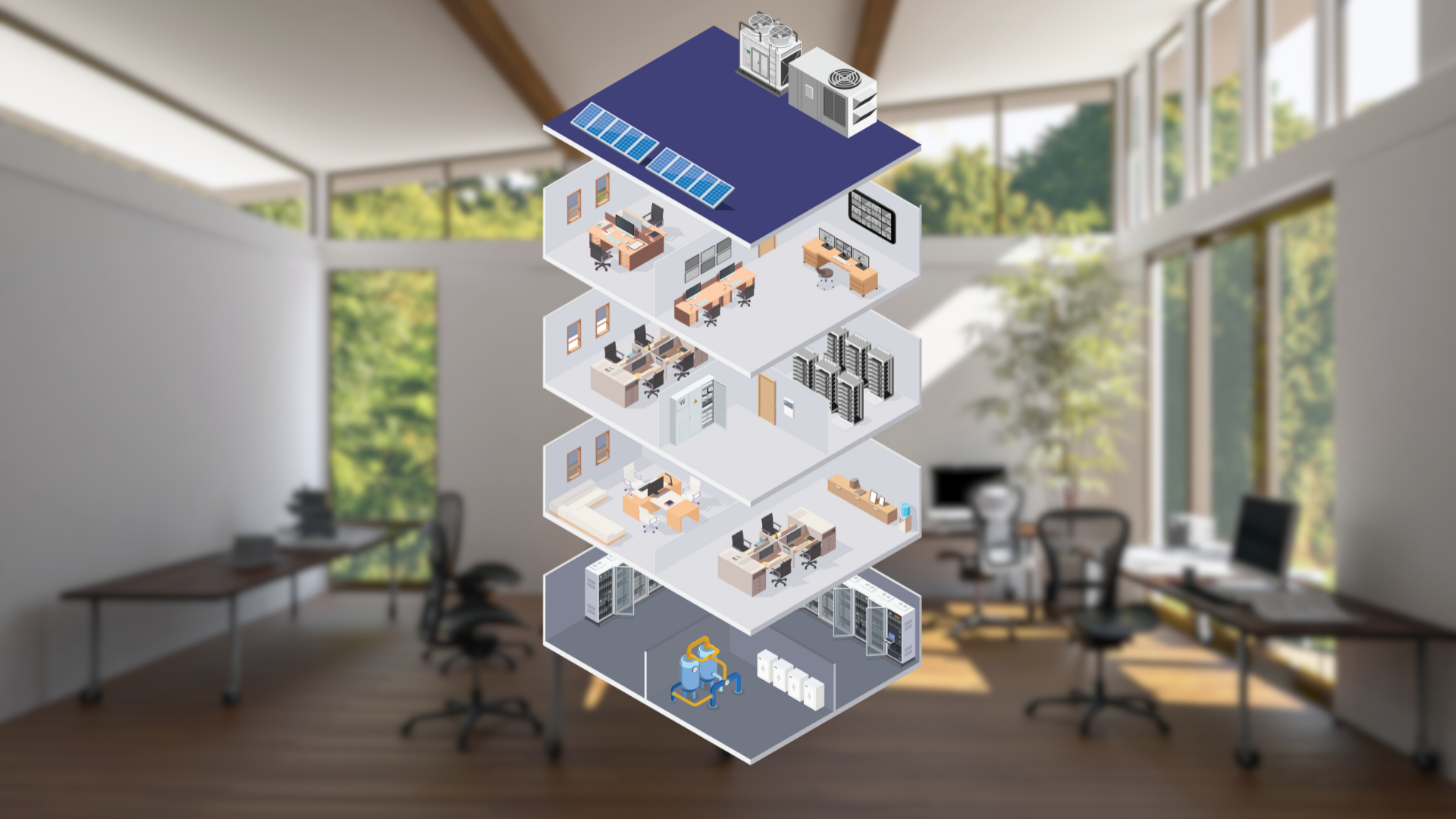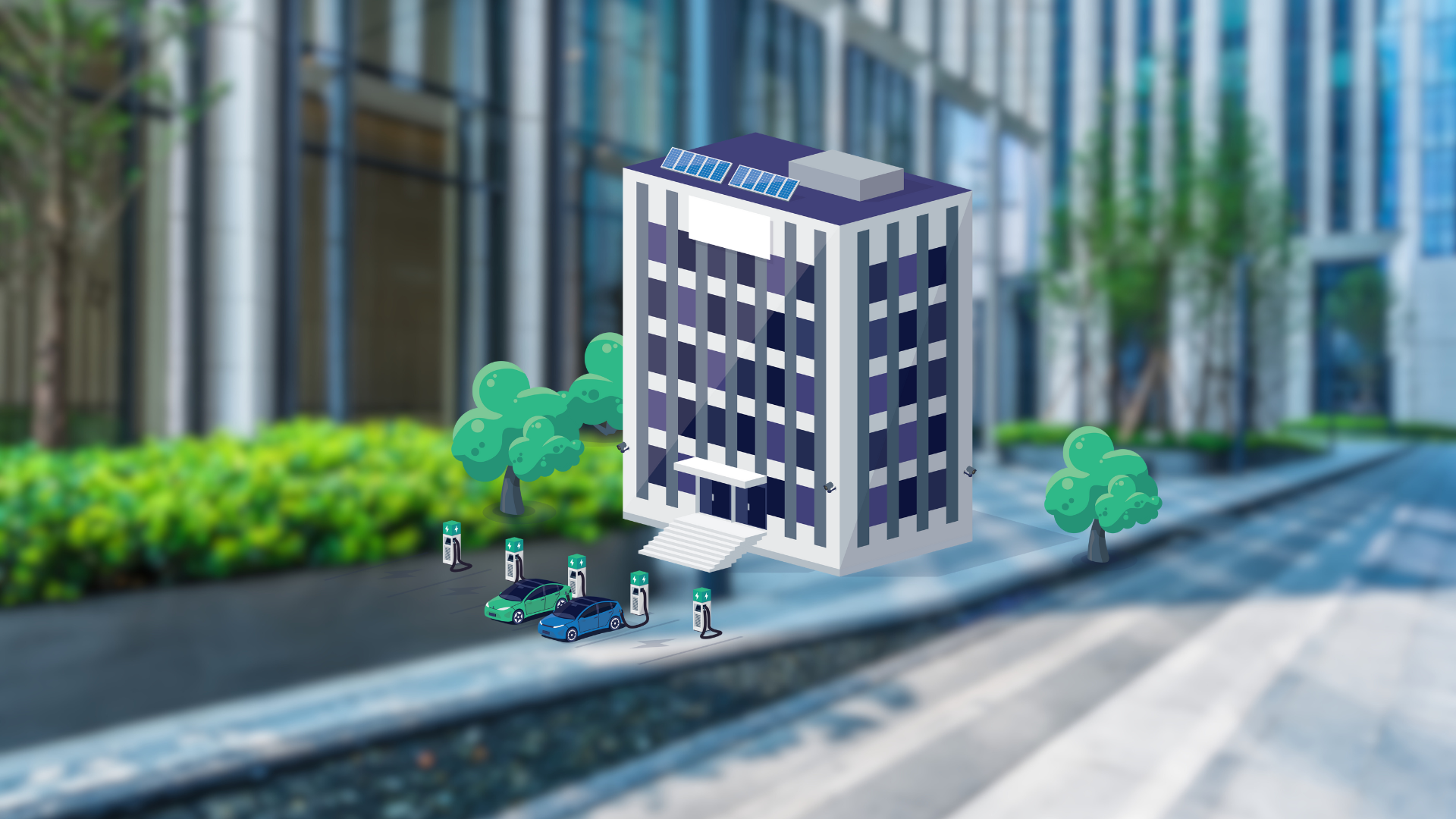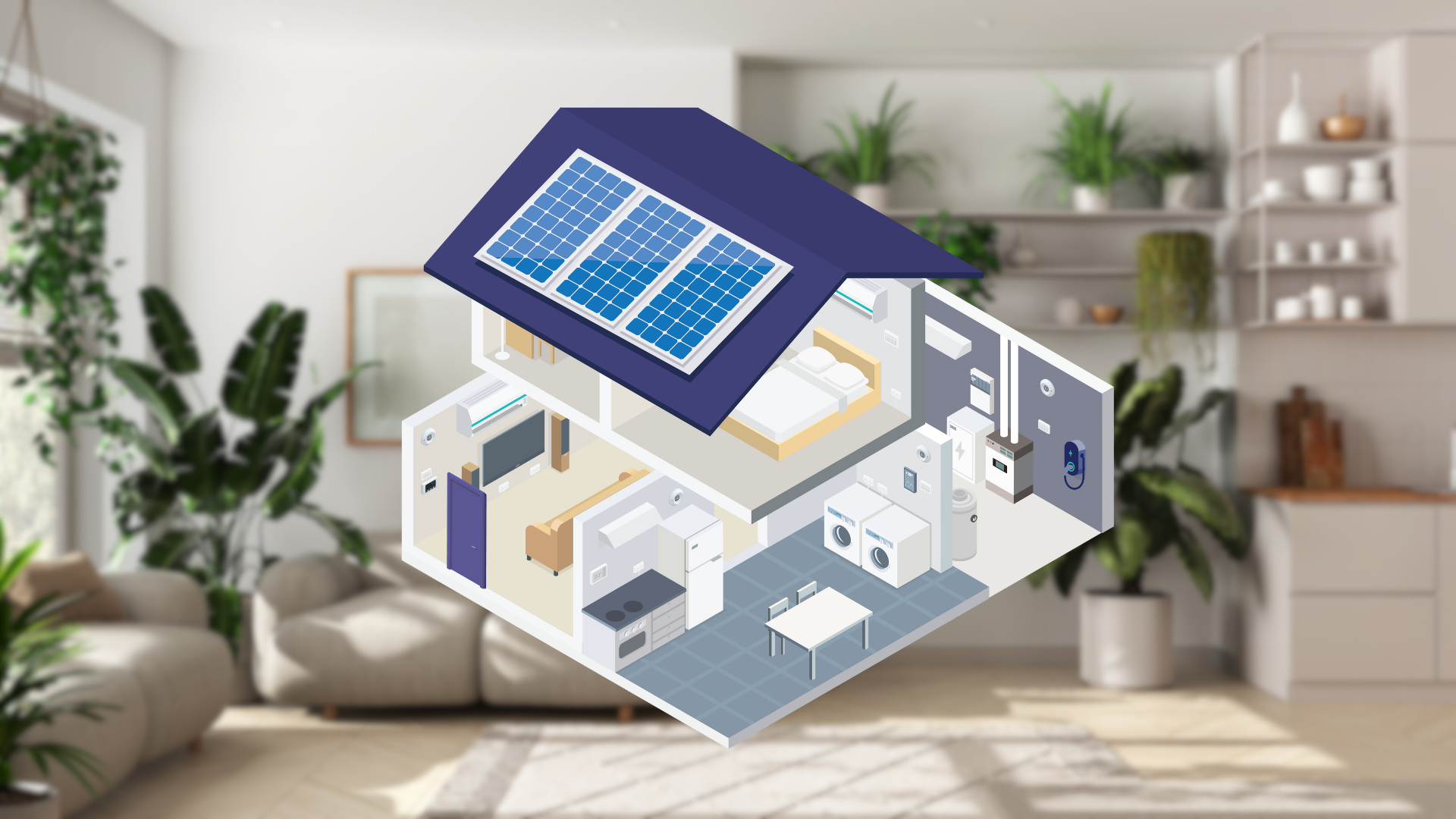Electricity and buildings: short-term cycles – long-term ambitions
The market in electrical equipment and systems for buildings can be cyclical. This has been well illustrated in recent times, particularly for the residential segment. Just a few years ago, energy prices had rocketed and inflation was at its highest for many years. Suddenly, it seemed that everyone wanted to install photovoltaic panels (PVs), with manufacturers building capacity in response. But now, interest rates have risen to counter inflation, energy prices have fallen back – and investment in buildings and demand for PVs has fallen, with overcapacity in supply undergoing a correction.
Yet cycles are a short-term phenomenon. The long-term trend for renewables and energy efficiency is relentlessly upward. In fact, the statistics are eye-watering. Governments must plan for increased consumption, with projections of global energy demand increasing by nearly 50% by 2050, compared with 2020[1], and demand for electricity almost doubling[2]. For countries to move away from fossil fuels, achieve their goals on climate change, and maintain a path towards net zero emissions by 2050, global electricity usage needs to grow 20% faster in the next decade than in the previous one[3]. In fact, renewables are likely to account for over 50% of the world’s energy mix by 2050[4]. In addition, grids will need to grow to supply this extra electricity, needing an estimated $3.1tn in investment worldwide by 2030[5]. Leaders have clearly seen the need to respond to this challenge. At COP28, held in Dubai at the end of 2023, over 130 national governments agreed to work together to triple the world’s installed renewable energy capacity to at least 11,000 GW by 2030[6].
Legislation will drive massive demand for investment in renewables, the grid, and energy efficiency – especially in buildings.
Buildings take center stage on renewables and energy efficiency
Buildings are center stage in this push, with the European Union leading the way. They account for 40% of all energy usage in the EU[7] and 36% of its emissions[8]. What’s more, it’s estimated that a staggering 75% of Europe’s buildings are currently energy inefficient5. On renewables, preliminary analysis suggests that implementing the revised, 2024, EU Energy Performance of Buildings Directive (EPBD) could result in 56 million homes powered by solar[9], and the union’s solar standard will see panels fitted to new residential buildings by 2029, across the vast rooftop areas of new public buildings by 2026, and to all public buildings by 2030[10].
Putting all this together, the picture is clear. Legislation will drive massive demand for investment in renewables, the grid, and energy efficiency – especially in buildings. And it’s a picture that Sonepar, the world leader in B-to-B distribution of electrical equipment, solutions, and services, will be at the center of.

A broad range of customers all sharing common challenges
While world leaders might wish they had one, there is no magic wand to power buildings by renewables or make them energy efficient. It needs both demand from end users, something that will be heavily driven by government initiatives, and an entire supply chain that’s ready to meet it. At the end of the chain, and critical to achieving climate change goals for buildings, are Sonepar’s customers – installers. These companies work in a wide range of segments and through an array of sizes and specialisms. They may be small, medium, or large companies spanning building types that range from housing, to commercial premises, schools, or hospitals. They can be specialized firms working for industrial customers in areas such as control and automation. Or they might be external or in-house teams dedicated to large installations, such as utilities.
The range of players is vast but they share two common challenges. First, in a world bracing for a step change in demand for renewables and energy efficiency, installers increasingly need to work smarter and more efficiently – a challenge brought into sharp focus by the lack of skilled people coming onto the labor market. Second, and critical, is the requirement to maintain know-how in a world of rapidly advancing technologies. This goes hand in hand with the need to be able to install integrated systems, not just individual equipment items. In a world where a commercial customer wants high current chargers for their electric car fleet, fed by solar panels from the roof, with a bank of batteries to store excess energy and reduce demand from the grid at peak times, a traditional electrical services company could easily be left behind.

Sonepar – helping its customers gear up and keep up
As the market leader in electrical components and systems, with €33bn in sales, of which €2Bn are in renewables and 70% come from the buildings sector, increasing numbers of customers are turning to Sonepar to help them meet their challenges. The group has a clear strategy. The core building block is its focus on highly efficient supply chains. Sonepar’s €2.5Bn investment in logistics, spanning 40 countries, and covering 200 warehouses and 25 automated distribution centers, means customers can get exactly what they need, and quickly. In addition, the group’s €1Bn investment in its omnichannel, customer-centric platform, Spark, means they can create and order the packages they need online – cutting both the time to order and the time to site. €11Bn of Sonepar’s sales already happen this way. All this results in greater effectiveness and efficiency as installers gear up for the changes to come.
But Sonepar doesn’t just help its customers gear up – it helps them keep up too. It already offers excellence in supplying them with the equipment and systems they need – whether switches and cables, power distribution, or automation. But it also provides an essential service in offering the technologies and know-how that go with ever-more complex solutions, a need that’s increasing as even generalist installers realize that they too must now become specialists. Sonepar does this through a combination of anticipating and preparing for an integrated future, acquiring the technologies and expertise the market needs, and spreading know-how throughout the group and, ultimately, to its customers.
Sonepar’s aim is to look firmly into the future to enable its customers to install integrated systems, not just their parts.
Anticipating the future through the integrated buildings ecosystem
Sonepar’s aim is to look firmly into the future to enable its customers to install integrated systems, not just their parts. It begins with the idea that electrical equipment for buildings form a complex ecosystem encompassing new technologies and with energy management systems at its heart. Sonepar is investing heavily both in transforming its own operations and in making the concept of the ecosystem mainstream in the sector. It’s also determined that this investment will be made in every one of its companies and across every one of its countries. The group is currently working hard to map the market. It has a specialist task force led by the Netherlands, Germany, and France, the countries that are the most mature in the area, that is focused on transforming Sonepar’s buildings business model towards one of energy management systems and ensuring that this can be rolled out across the group in the future.
Sonepar is also in focused discussions with its key suppliers – to clearly understand both the systems its customers need and which companies will be the right partners to provide them. As well as offering the latest technologies as they come to market, delivering this will see Sonepar move from providing the components for energy in buildings – such as HVAC, lighting control, and energy storage – to providing the software and online licenses for the energy management systems that will integrate these elements into a single ecosystem. But delivering this is no easy task – in some respects, it requires an entirely new business model. Providing, and advising on, tomorrow’s technologies needs expertise, and software for integration must be tailored to each customer and come with ongoing support.

Acquiring the technologies and know-how customers need
One way that Sonepar accelerates this transformation is its policy of strategic acquisitions. These cover the entire buildings ecosystem from renewables to energy efficiency, and from infrastructure to computing. On the software side, in 2021, it took a majority shareholding in Factory Systemes Groupe, a major player in the distribution of software solutions, edge computing, and industrial IoT. Factory Systemes then went on to purchase Wonderware Italia, a leading supplier of industrial software solutions, with a focus on the digital transformation of operations.
On the hardware side, Sonepar has acquired Australian company Electrical Supply Solutions, which specializes in major energy infrastructure, making the group an important player in the pressing need for major grid investments. In 2022, it purchased French distributor, CD-Sud, enhancing its expertise in energy efficiency solutions. The following year saw the group secure a controlling interest in Swedish company Aprilice, which specializes in PV but also brings significant know-how in the associated areas of inverters, energy storage, and software. That same year, it acquired Alliantz, a privately owned distributor of photovoltaics and energy efficiency solutions.
Sonepar’s belief is that the challenges of the new building ecosystem can only be met by the continual transfer of knowledge.
Building expertise across the group
Sonepar’s aim in these acquisitions is not simply to build market share: it is to bring in new business models and expertise and then to scale them across the group. Sonepar’s belief is that the challenges of the new buildings ecosystem can only be met by the continual transfer of knowledge. As well as drawing directly on, and disseminating, the expertise brought by its strategic acquisitions, the company has put in place dedicated Product Management (PM) teams that bring together specialists from across its geographies, and are centered on Europe, Asia Pacific, and South America. And, as Sonepar’s service ultimately relies on its associates on the ground, its people are continually receiving training from key suppliers as equipment and systems for the buildings market evolve rapidly.
Electricity and the buildings sector – an overwhelmingly positive outlook
Regardless of short-term cycles, new government commitments on climate change, and the regulation that involves, will drive a revolution in demand for both renewables and energy efficiency. And it’s a revolution that Sonepar will be at the heart of: helping customers gear up and work smarter through significant supply chain investments; shaping the future of the buildings electrical ecosystem through a move to energy management; gathering the technologies and know-how needed to meet the challenges through strategic acquisitions; and then spreading this expertise throughout the world through dedicated structures. The ambition to tackle emissions is high, and Sonepar aims to be just as ambitious in helping deliver it.
1] Source: US Energy Information Administration (EIA)
[2] Source: International Energy Agency (IEA)
[5] Source: Rystad Energy
[6] Source: COP 28 UEA
[9] Source: SolarPower Europe
[10] Source: SolarPower Europe